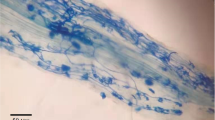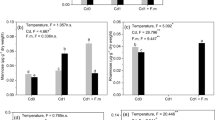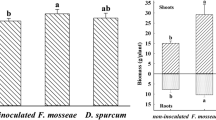Abstract
Aims
Low molecular weight soluble compounds in rhizosphere soils are important composition of soil organic carbon, which are mainly derived from root exudates and easily affected by biological and abiotic factors. Here, we investigated the effect of arbuscular mycorrhizal fungi (AMF, Funneliformis mosseae) on soluble sugars, flavonoids, and phenolic acids in the rhizosphere soil of black locust seedlings grown under elevated CO2 and Cd-contaminated soils.
Results
F. mosseae decreased (p < 0.05) contents of mannose, glucose, galactose, arabinose, total flavonoids, quercetin, total phenolic acids, gallic acid, chlorogenic acid, p-hydroxybenzoic acid, and caffeic acid in rhizosphere soils under elevated CO2 + Cd; however, the concentration of p-coumaric acid increased (p < 0.05). Additionally, F. mosseae led to significant decreases in mannose, galactose, quercetin, gallic acid, chlorogenic acid, and p-hydroxybenzoic acid in roots under elevated CO2 + Cd; however, glucose content in roots increased (p < 0.05). Contents of small compounds in roots significantly affected low molecular weight soluble compounds in rhizosphere soils, and F. mosseae colonization rate and rhizosphere soil C, pH, and DTPA-Cd significantly influenced the accumulation of low molecular weight soluble compounds.
Conclusions
F. mosseae colonization significantly decreased the accumulation of low molecular weight soluble compounds in the rhizosphere of black locust under elevated CO2 + Cd, leading to significant increases in pH and Cd content in rhizosphere soils, which could improve our understanding of the regulation of AMF on rhizosphere soil carbon pool and the migration of heavy metals under elevated CO2 scenarios.







Similar content being viewed by others
Data Availability
The datasets are available upon reasonable request.
References
AbdElgawad H, El-Sawah AM, Mohammed AE, Alotaibi MO, Yehia RS, Selim S, Saleh AM, Beemster GTS, Sheteiwy MS (2022a) Increasing atmospheric CO2 differentially supports arsenite stress mitigating impact of arbuscular mycorrhizal fungi in wheat and soybean plants. Chemosphere 296:134044
AbdElgawad H, Sheteiwy MS, Saleh AM, Mohammed AE, Alotaibi MO, Beemster GTS, Madany MMY, van Dijk JR (2022b) Elevated CO2 differentially mitigates chromium (VI) toxicity in two rice cultivars by modulating mineral homeostasis and improving redox status. Chemosphere 307:135880
Alotaibi MO, Saleh AM, Sobrinho RL, Sheteiwy MS, Ei-Sawah AM, Mohammed AE, AbdElgawad F (2021) Arbuscular mycorrhizae mitigate aluminum toxicity and regulate proline metabolism in plants grown in acidic soil. J Fungi. https://doi.org/10.3390/jof7070531
Atasie VN, Akinhanmi TF, Ojiodu CC (2009) Proximate analysis and physico-chemical properties of groundnut (Arachis hypogaea L.). Pask J Nutr 8(2):194–197
Badri DV, Vivanco JM (2009) Regulation and function of root exudates. Plant Cell Environ 32:666–681
Bago B, Pfeffer PE, Shachar-Hill Y (2000) Carbon metabolism and transport in arbuscular mycorrhizas. Plant Physiol 124:949–957
Barea JM, Palenzuela J, Cornejo P, Sánchez-Castro I, Navarro-Fernández C, Lopéz-García A, Estrada B, Azcón R, Ferrol N, Azcón-Aguilar C (2011) Ecological and functional roles of mycorrhizas in semi-arid ecosystems of Southeast Spain. J Arid Environ 75:1292–1301
Biermann B, Linderman RG (1981) Quantifying vesicular-arbuscular mycorrhizae: a proposed method towards standardization. New Phytol 87(1):63–67
Bisht A, Garg N (2022) AMF species improve yielding potential of Cd stressed pigeonpea plants by modulating sucrose-starch metabolism, nutrients acquisition and soil microbial enzymatic activities. Plant Growth Regul 96:409–430
Cao KM, Jia X, Zhang CY, Wang L, Zhang NJ, Gao YF, Wang ZW (2022) Combined effect of elevated atmospheric CO2 and Cd contamination on flavonoids accumulation in rhizosphere soil of Robinia pseudoacacia L. seedlings. J Northwest A&F Univ 50:34–44 (In Chinese)
Ekmekçi Y, Tanyolaç D, Ayhan B (2008) Effects of cadmium on antioxidant enzyme and photosynthetic activities in leaves of two maize cultivars. J Plant Physiol 165:600–611
Feng G, Zhang FS, Li XL, Tian CY, Tang C, Rengel Z (2002) Improved tolerance of maize plants to salt stress by arbuscular mycorrhiza is related to higher accumulation of soluble sugars in roots. Mycorrhiza 12:185–190
Ghasemzadeh A, Ghasemzadeh N (2011) Flavonoids and phenolic acids: Role and biochemical activity in plants and human. J Med Plants Res 5:6697–6703
Grandy AS, Erich MS, Porter GA (2000) Suitability of the anthrone-sulfuric acid reagent for determining water soluble carbohydrates in soil water extracts. Soil Biol Biochem 32:725–727
Gunina A, Kuzyakova Y (2015) Sugars in soil and sweets for microorganisms: Review of origin, content, composition and fate. Soil Biol Biochem 90:87–100
Haichar FZ, Santaella C, Heulin T, Achouak W (2014) Root exudates mediated interactions belowground. Soil Biol Biochem 77:69–80
Hamid Y, Tang L, Hussain B, Usman M, Lin Q, Rashid MS, He Z, Yang X (2020) Organic soil additives for the remediation of cadmium contaminated soils and their impact on the soil-plant system: a review. Sci Total Environ 707:136121
Hussain HA, Zhang QW, Hussain S, Li HB, Waqqas A, Zhang L (2021) Effects of arbuscular mycorrhizal fungi on maize growth, root colonization, and root exudates varied with inoculum and application method. J Soil Sci Plant Nut 21:1577–1590
IPCC (2014) Climate Change 2014: Synthesis Report. Contribution of working Groups I, II and III to the fifth assessment report of the intergovernmental panel on climate change [Core Writing Team, Pachauri RK, Meyer LA (eds)]. Geneva, pp 151
Janeeshma E, Puthur JT, Wróbel J, Kalaji HM (2022) Metabolic alterations elicited by Cd and Zn toxicity in Zea mays with the association of Claroideoglomus claroideum. Ecotoxicology 31:92–113
Jia X, Zhao YH, Liu T, Hang SP (2016) Elevated CO2 affects secondary metabolites in Robinia pseudoacacia L. seedlings in Cd- and Pb-contaminated soils. Chemosphere 160:199–207
Jia X, Zhao JM, Zhang NJ, Zhao YH, Zhang CY, Wang L, Cao KM, Gao YF (2021) Elevated atmospheric CO2 generally improved soluble sugars content in the rhizosphere soil of black locust seedlings under cadmium exposure. Plant Soil 468:197–209
Jin J, Tang CX, Sale P (2015) The impact of elevated carbon dioxide on the phosphorus nutrition of plants: a review. Ann Bot-London 116:987–999
Johnson NC, Wolf J, Reyes MA, Panter A, Koch GW, Redman A (2005) Species of plants and associated arbustcular mycorrhizal fungi mediate mycorrhizal responses to CO2 enrichment. Glob Chang Biol 11:1156–1166
Kaur S, Suseela V (2020) Unraveling arbuscular mycorrhiza-induced changes in plant primary and secondary metabolome. Metabolites 10:335
Kuzyakov YV (2001) Tracer studies of carbon translocation by plants from the atmosphere into the soil (a review). Eurasian Soil Sci 34:28–42
Liang SC, Jiang Y, Li MB, Zhu WX, Xu N, Zhang HH (2019) Improving plant growth and alleviating photosynthetic inhibition from salt stress using AMF in alfalfa seedlings. J Plant Interact 14:482–491
Ma JQ, Wang WQ, Yang J, Qin SF, Yang YS, Sun CY, Pei G, Zeeshan M, Liao HL, Liu L, Huang JG (2022) Mycorrhizal symbiosis promotes the nutrient content accumulation and affects the root exudates in maize. BMC Plant Biol 22:64
Mandal SM, Chakraborty D, Dey S (2010) Phenolic acids act as signaling molecules in plant-microbe symbioses. Plant Signal Behav 5:359–368
Mechri B, Tekaya M, Cheheb H, Attia F, Hammami M (2015) Accumulation of flavonoids and phenolic compounds in olive tree roots in response to mycorrhizal colonization: A possible mechanism for regulation of defense molecules. J Plant Physiol 185:40–43
Mohammed AE, Alotaibi MO, Elobeid M (2022) Interactive influence of elevated CO2 and arbuscular mycorrhizal fungi on sucrose and coumarin metabolism in Ammi majus. Plant Physiol Biochem 185:45–54
Nakayama M, Tateno R (2018) Solar radiation strongly influences the quantity of forest tree root exudates. Trees 32:871–879
Okem A, Stirk WA, Street RA, Southway C, Finnie JF, Staden JV (2015) Effects of Cd and Al stress on secondary metabolites, antioxidant and antibacterial activity of Hypoxis hemerocallidea Fisch. & C.A. Mey. Plant Physiol Biochem 97:147–155
Panneerselvam P, Sahoo S, Senapati A, Kumar U, Mitra D, Parameswaran C, Anandan A, Kumar A, Jahan A, Nayak AK (2019) Understanding interaction effect of arbuscular mycorrhizal fungi in rice under elevated carbon dioxide conditions. J Basic Microbiol 59:1217–1228
Prosser JI, Bohannan BJM, Curtis TP, Elis RJ, Firestone MK, Freckleton RP, Green JL, Green LE, Killham K, Lennon JJ, Osborn AM, Solan M, van de Gast CL, Young JPW (2007) The role of ecological theory in microbial ecology. Nat Rev Microbiol 5:384–392
Rajtor M, Piotrowska-Seget Z (2016) Prospects for arbuscular mycorrhizal fungi (AMF) to assist in phytoremediation of soil hydrocarbon contaminants. Chemosphere 162:105–116
Saleh AM, Abdel-Mawgoud M, Hassan AR, Habeeb TH, Yehia RS, Abdelgawad H (2020) Global metabolic changes induced by arbuscular mycorrhizal fungi in oregano plants grown under ambient and elevated levels of atmospheric CO2. Plant Physiol Biochem 151:255–263
Schubert A, Allara P, Morte A (2003) Cleavage of sucrose in roots of soybean (Glycine max) colonized by an arbuscular mycorrhizal fungus. New Phytol 161:495–501
Shen Z, Ruan Y, Chao X, Zhang J, Li R, Shen Q (2015) Rhizosphere microbial community manipulated by 2 years of consecutive biofertilizer application associated with banana Fusarium with disease suppression. Biol Fert Soils 51:553–562
Sheteiwy MS, AbdElgawad H, Xion YC, Macovei A, Brestic M, Skalicky M, Shaghaleh H, Alhaj Hamound Y, El-Sawah AM (2021) Inoculation with Bacillus amyloliquefaciens and mycorrhiza confers tolerance to drought stress and improve seed yield and quality of soybean plant. Physiol Plant 172:2153–2169
Sheteiwy MS, El-Sawah AM, Korany SM, Alsherif EA, Mowafy AM, Chen J, Jośko I, Selim S, AbdElgawad H (2022) Arbuscular mycorrhizal fungus "Rhizophagus irregularis" impacts on physiological and biochemical responses of ryegrass and chickpea plants under beryllium stress. Environ Pollut 315:120356
Staddon PL, Reinsch S, Olsson PA, Ambus PA, Ambus P, Lϋscher A, Jakobsen L (2014) A decade of free-air CO2 enrichment increased the carbon throughput in a grass-clover ecosystem but did not drastically change carbon allocation patterns. Funct Ecol 28:538–545
Vierheilig H, Coughlan AP, Wyss U, Piché Y (1998) Ink and Vinegar, a simple staining technique for arbuscular mycorrhizal fungi. Appl Environ Microbiol 64:5004–5007
Vives-Peris V, de Ollas C, Gómez-Cadenas A, Pérez-Clemente RM (2020) Root exudates: from plant to rhizosphere and beyond. Plant Cell Rep 39:3–17
Wang L, Jia X, Zhao YH, Zhang CY, Gao YF, Li XD, Cao KM, Zhang NJ (2021) Effects of elevated CO2 on arbuscular mycorrhizal fungi associated with Robinia pseudoacacia L. grown in cadmium-contaminated soils. Sci Total Environ 768:144453
Wang ZW, Jia X, Yan ZK, Cao KM, Zhang CY, Wang L, Zhang NJ, Gao YF (2021b) Responses of phenolic acids accumulation in the rhizosphere soil of Robinia pseudoacacia L. seedlings to the combination of elevated atmospheric CO2 and Cd exposure. Chin J Ecol 40:2067–2075 (In Chinese)
Wu YH, Wang H, Liu M, Li B, Chen X, Ma YT, Yan ZY (2021) Effects of native arbuscular mycorrhizae isolated on root biomass and secondary metabolites of Salvia miltiorrhiza bge. Front Plant Sci 12:617892
Xiong H, Duan C, A XX, Chen MH (2013) Response of scutellarin content to heavy metal in Erigeron breviscapus. Int J Environ Sci Dev 4:277–281
Yu ZH, Zhao XL, Su L, Yan K, Li B, He YM, Zhan FD (2021) Effect of an arbuscular mycorrhizal fungus on maize growth and cadmium migration in a sand column. Ecotoxicol Environ Saf 225:112782
Yuan XH, Xue ND, Han ZG (2021) A meta-analysis of heavy metals pollution in farmland and urban soils in China over the past 20 years. J Environ Sci 101:217–226
Zan NR, Datta SP, Rattan RK, Dwivedi BS, Meena MC (2013) Prediction of the solubility of zinc, copper, nickel, cadmium, and lead in metal-contaminated soils. Environ Monit Assess 185:10015–10025
Zhang Y, Li SF, Wu XW (2008) Pressurized liquid extraction of flavonoids from Houttuynia cordata Thunb. Sep Purif Technol 58:305–310
Zhang Y, Yu ZY, Geng FN, Wu TQ, Yang L, Xiao H, Zhao Y, Liu H (2018) Content determination of total phenolic acids in extract of Taraxacum mongolicum. Food Res Dev 39(3):123–126 (In Chinese)
Zhang J, Wang P, Tian H, Xiao Q, Jiang H (2019) Pyrosequencing-based assessment of soil microbial community structure and analysis of soil properties with vegetable planted at different years under greenhouse conditions. Soil Tillage Res 187:1–10
Zhang CY, Jia X, Zhao YH, Wang L, Cao KM, Zhang NJ, Gao YF, Wang ZW (2021) The combined effects of elevated atmospheric CO2 and cadmium exposure on flavonoids in the leaves of Robinia pseudoacacia L. seedlings. Ecotoxicol Environ Saf 210:111878
Funding
This work was jointly supported by the National Natural Science Foundation of China (grant Nos. 31870582 and 31270665) and the Project Supported by Shaanxi Key Laboratory of Land Consolidation of China (Program No. 2019TD-01).
Author information
Authors and Affiliations
Contributions
Performed experiments, analyzed data, and wrote the manuscript. Yunfeng Gao and Yonghua Zhao provided the help for experiments. Xia Jia planned and designed the research, and reviewed and edited the manuscript. All authors commented on previous versions of the manuscript. All authors read and approved the final manuscript.
Corresponding author
Ethics declarations
Competing interests
The authors declare that they have no known competing financial interests or personal relationships that could have appeared to influence the work reported in this paper.
Additional information
Responsible Editor: Juan Barcelo.
Publisher's note
Springer Nature remains neutral with regard to jurisdictional claims in published maps and institutional affiliations.
Yunjie Wang, Chunyan Zhang and Lu Wang are co-first author.
Rights and permissions
Springer Nature or its licensor (e.g. a society or other partner) holds exclusive rights to this article under a publishing agreement with the author(s) or other rightsholder(s); author self-archiving of the accepted manuscript version of this article is solely governed by the terms of such publishing agreement and applicable law.
About this article
Cite this article
Wang, Y., Zhang, C., Wang, L. et al. Influence of arbuscular mycorrhizal fungi on low molecular weight soluble compounds in the rhizosphere soil of black locust seedlings grown in cadmium-contaminated soils under elevated CO2 scenarios. Plant Soil 486, 469–486 (2023). https://doi.org/10.1007/s11104-023-05885-z
Received:
Accepted:
Published:
Issue Date:
DOI: https://doi.org/10.1007/s11104-023-05885-z




